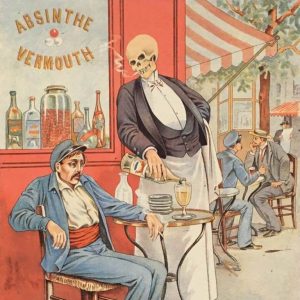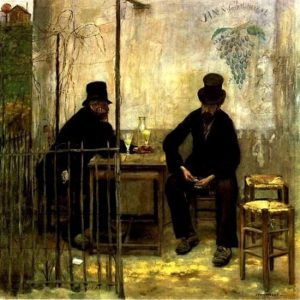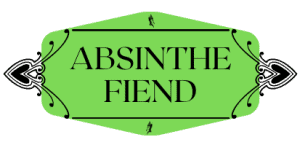Absinthe has long captivated the imaginations of artists, writers, and free spirits. With its mysterious allure, storied history, and ritualistic preparation, absinthe has transcended mere beverage status to become a symbol of artistic rebellion and intellectual curiosity.
Among the many subcultures that have embraced the enigmatic charm of absinthe, few have done so with as much fervor and passion as the Goth community.
Goth culture, with its deep appreciation for the dark, the romantic, and the unconventional, finds a kind of kindred spirit in absinthe. This article delves into the historical and cultural ties that bind absinthe to Goth culture, exploring how this once-banned elixir has become an enduring icon of Gothic expression.
From the shadowy corners of 19th-century Parisian cafés to modern-day Goth gatherings, we will uncover the intricate relationship between absinthe and the Goth subculture, shedding light on how this verdant potion continues to cast its spell.

Historical Background of Absinthe
The story of absinthe begins in the late 18th century in the Swiss town of Couvet, where it was first crafted as an elixir by Dr. Pierre Ordinaire. Its potent blend of wormwood, anise, and other botanicals quickly gained a reputation for its medicinal properties.
By the early 19th century, absinthe had crossed the border into France, where it found a fervent following among soldiers returning from the Algerian War, who praised its refreshing qualities.
Absinthe’s popularity soared during the Belle Époque, a period of artistic and cultural flourishing in Paris. It became the muse of many renowned artists and writers, including Vincent van Gogh, Oscar Wilde, and Edouard Manet (to name only a few!)
Among these creative geniuses, the drink was celebrated for its ability to inspire creativity and was often depicted in their works, contributing to its mystique and allure.
However, absinthe’s rise was not without controversy. Its high alcohol content and the presence of thujone, a compound found in wormwood, sparked fears of its potentially hallucinogenic effects.
By the early 20th century, absinthe had become the scapegoat for various social ills (including “The Absinthe Murders”), leading to its ban in many countries, including the United States in 1912 and France in 1915.
However, despite its prohibition, the legend of absinthe lived on. The late 20th century saw a revival of interest in this storied spirit, culminating in its legalization in the United States in 2007 and in France in 2011.
Today, absinthe enjoys a renaissance, celebrated for its rich history and complex flavors, and remains a symbol of artistic rebellion and intellectual exploration.
You Might Like: Debunking Absinthe Myths

Absinthe in Gothic Literature and Art
Absinthe’s intoxicating blend of mystery and allure has left an indelible mark on Gothic literature and art.
This enigmatic elixir, with its deep green hue and ritualistic preparation, has inspired countless Gothic tales and artworks, weaving itself into the very fabric of the genre.
In Gothic literature, absinthe often symbolizes decadence and otherworldliness.
Writers like Edgar Allan Poe and Charles Baudelaire, both known for their dark and brooding works, were reputedly influenced by absinthe. Its presence in their stories and poems evokes a sense of the surreal and the macabre, enhancing the eerie atmospheres they are famous for.
Furthermore, absinthe’s reputed hallucinogenic effects provided fertile ground for exploring common Gothic themes of madness, altered states of consciousness, and the supernatural.
Of course, the visual arts, too, have been profoundly influenced by absinthe.
The drink features prominently in the works of many Gothic artists, who are drawn to its rich symbolism and historical associations.
The ritual of absinthe preparation, with its slow drip of water over a sugar cube, has been immortalized in countless paintings and illustrations, capturing the drink’s hypnotic allure.
Artists like Édouard Manet and Henri de Toulouse-Lautrec depicted absinthe drinkers in their works, often portraying them in states of introspection or melancholy, thus reinforcing the drink’s association with the Gothic aesthetic.
Though absinthe’s impact extends beyond traditional art forms into modern interpretations as well.
Contemporary Gothic artists and illustrators continue to draw inspiration from absinthe, blending its historic mystique with modern sensibilities.
This fusion is evident in works that combine absinthe’s phantasmagoric elements with Neo-Victorian and Steampunk influences, creating a rich tapestry of visual and thematic depth.
Absinthe’s role in Gothic literature and art (whether we’re talking classical or contemporary) is a testament to its enduring power as a muse. Its ability to evoke a sense of mystery, darkness, and the supernatural continues to captivate and inspire, making it an integral part of the Gothic tradition.

The Symbolism of Absinthe in Goth Culture
Absinthe holds a unique and powerful symbolism within Goth culture, embodying themes of rebellion, mystery, and artistic expression.
This green elixir, often referred to as “The Green Fairy,” is more than just a drink; it is a cultural icon that resonates deeply with the Gothic ethos.
Firstly, absinthe symbolizes rebellion and non-conformity.
Its history of being banned and demonized by authorities mirrors the Goth subculture’s embrace of the unconventional and the taboo. Just as Goths often challenge societal norms through their fashion, music, and art, absinthe represents a defiance against mainstream acceptance and a celebration of the avant-garde.
The ritualistic preparation of absinthe also appeals to the Goth aesthetic.
The slow, deliberate process of dripping water over a sugar cube until it dissolves into the green liquid is almost alchemical, evoking a sense of magic and transformation. This ritual aligns neatly with the Goth fascination with the arcane and the mysterious, adding a layer of depth to the drinking experience.
Moreover, absinthe’s association with famous artists and writers of the 19th and early 20th centuries—figures often admired within Goth circles—further cements its symbolic status.
Many famous icons who are still celebrated today for their dark, introspective works were known to indulge in absinthe, thus linking the drink to creative and intellectual pursuits.
Aesthetically, absinthe’s vibrant green color and its historical ties to the bohemian lifestyle complement the Gothic appreciation for beauty in the macabre. The drink’s visual appeal and storied past make it a fitting emblem for a subculture that finds allure in the shadows and the extraordinary.
Absinthe is a potent symbol of non-conformity, artistic inspiration, and the beauty of the mysterious. It encapsulates the spirit of rebellion and creativity, making it an enduring icon within the Goth community.

Modern Goths and Absinthe
In contemporary times, absinthe continues to hold a special place within Goth culture, seamlessly blending historical allure with modern sensibilities.
Today’s Goths embrace absinthe not just for its storied past but for the unique experiences it offers, both socially and aesthetically.
Modern Goths often incorporate absinthe into their gatherings and events, using it as a centerpiece for social rituals that echo the drink’s rich traditions. The preparation of absinthe, with its slow drip of water over a sugar cube, serves as a communal activity that fosters connection and conversation.
This ritualistic aspect appeals to the Goth love for the dramatic and the ceremonial, turning the act of drinking absinthe into a shared, almost theatrical experience. Special glassware and accoutrements like fountains or a good balancier raise the occasion all the more!
Absinthe’s resurgence in popularity has also led to a variety of contemporary interpretations and innovations.
Goth bars and clubs frequently feature absinthe cocktails, blending the classic drink with modern mixology to create new and intriguing flavors. (The most common are the classic Corpse Reviver No 2 and Ernest Hemingway’s particularly potent Death in the Afternoon.)
These establishments often use absinthe to craft drinks that not only taste unique but also look visually striking, playing into the Goth appreciation for aesthetics and presentation.
Furthermore, absinthe’s association with artistic and literary figures of the past continues to inspire modern Goths.
Many in the community view absinthe as a symbol of creative freedom and intellectual exploration, drawing parallels between their own artistic endeavors and those of historical figures who found inspiration in the drink.
This connection to a lineage of rebellious, avant-garde artists reinforces absinthe’s status as a cultural touchstone within the Goth scene.
Whether enjoyed in a dimly lit bar or at a private gathering, absinthe remains a potent emblem of Gothic identity and expression.

Conclusion
Absinthe, with its rich history and enigmatic allure, has found a natural home in modern Goth culture.
From its storied past among rebellious artists to its symbolic presence in modern gatherings, literature, and media, absinthe encapsulates the essence of Gothic mystique and creativity.
As both a drink and a cultural icon, it continues to inspire and captivate, making it an enduring emblem of the Goth community’s love for the dark, the mysterious, and the extraordinary.

